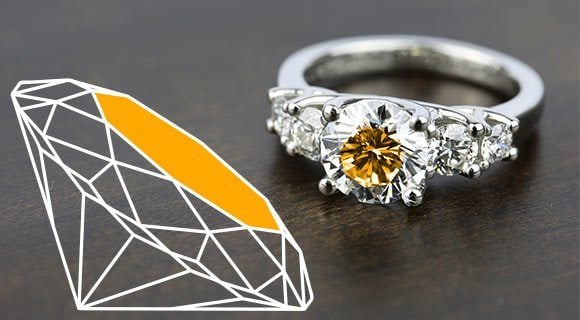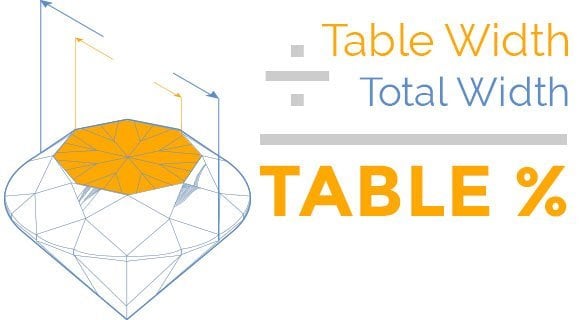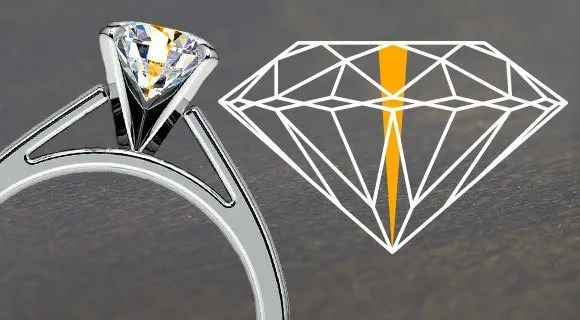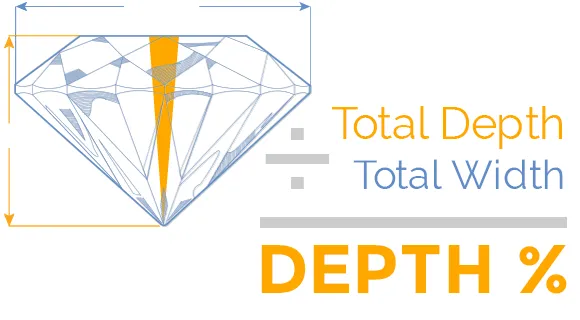Let’s take a closer look at two factors affecting the cut quality of a diamond, a diamond’s table and depth. They both helps to define the physical shape of a diamond and contribute to its sparkle, creating that dazzling look we’ve all come to love. When these two features are proportioned just right, a diamond of any size will look spectacular.

What is A Diamond’s Table?
Have you ever noticed that nearly every diamond has a flat, square-shaped facet on its top? This flat facet is called the table, and it plays a critical role in a diamond’s appearance. The table refracts rays of light as they pass, directing them to the facets that make the diamond look so sparkly.
It is important to note that when it comes to the table, bigger is not always better. If the table on a diamond is too large, the upper facets on the crown don’t have room to disperse light. If the table is too small, there won’t be much light getting into the stone, diminishing its overall brilliance.

The physical size of the table facet naturally varies depending on the overall size of the diamond. That’s why jewelers measure the table percentage when grading a diamond’s cut. Table percentage is calculated by dividing the width of the table by the overall width of the diamond.
The ideal table percentage will vary based on the shape of your diamond. For example, the ideal table for round-cut diamonds is between 54-60 percent, while the ideal dimensions for emerald-cut diamonds puts table percentage between 66-72 percent.
While the difference in these numbers may seem insignificant, they can have a major impact on the overall appearance and brightness of your diamond.

What is A Diamond’s Depth?
The depth of a diamond might also be called the “height”: it is the distance from the table to the culet (the pointed tip) of the diamond.
Like with a diamond’s table, jewelers grade a diamond’s depth based on its depth percentage. Depth percentage is the diamond’s depth divided by the width of the diamond. This percentage dictates the overall proportions of the diamond, which in turn directly impact how light reflects off the facets in the stone.

Because of this, depth contributes to the diamond’s sparkle in a big way. If a cut is too shallow, light will simply pass through the stone and leave through the pavilion (the lower half) without any reflection. On the other hand, a cut that is too deep will have poor sparkle and make the stone appear smaller than other stones of the same carat weight.
While the ideal depth will also vary based on shape, look for a diamond that allows light to bounce around the facets, creating that gorgeous, eye-catching sparkle.

How To Find the Right Depth & Table
Ultimately, the depth and table of a diamond determine how well the stone reflects light. But how do you know what the ideal measurements are—and what do you do if your budget is limited? Don’t worry! The values for the depth and table are measured in percentages. This is a good thing because percentages remain consistent regardless of a diamond’s size. Any diamond, from half a carat to the Hope Diamond, can have an ideal depth and table, though keep in mind that the ideal range is different for each diamond shape.
Ideal Diamond Depths and Tables
Find the ideal depth and table range for each diamond shape by clicking on the links in the table below.


















